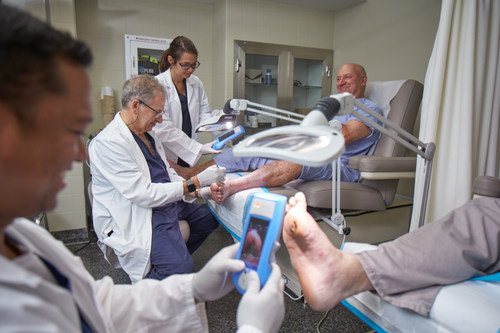Study Confirms the Utility of MolecuLight to Inform Clinicians to the Presence and Location of Clinically Significant Bacteria and Improves Treatment Plans & Outcomes over Conventional Diagnostic Methods
LEEDS, UK and TORONTO, July 13, 2022 /PRNewswire/ – MolecuLight Inc., the leader in fluorescence imaging for detection and localization of elevated bacterial load in wounds, announced the publication of an independent, blinded randomized controlled trial in Diabetes Care. The publication on this 56-patient trial, titled “The use of Point-of-Care Bacterial Autofluorescence Imaging in the Management of Diabetic Foot Ulcers: A Pilot Randomized Controlled Trial“1 reported that the use of a MolecuLight i:X® device to visualize the presence of elevated bacterial burden in wounds doubled 12-week wound healing rates (204%) in diabetic foot ulcer patients over standard-of-care alone.

Diabetes is a significant global health ailment: over 416 million people have diabetes worldwide2 and 25% of these patients develop a diabetic foot ulcer (DFU)3, greatly diminishing quality of life and increasing the need for costly and extended treatment. In the UK, the NHS spends £1 billion ($1.25 billion US) annually on DFU care and management24.
“As a clinician in wound care, especially when managing patients with chronic wounds, the holy grail is improvement in wound healing rates”, says David Russell, Associate Professor in Vascular Surgery at University of Leeds and lead author in the study. “In our randomized controlled trial, the results were impressive – the use of a MolecuLight device to inform our wound care decision-making helped us double the number of wounds that were healed at 12 weeks. This has benefits for the patient and our healthcare system.”
Patients were stratified into two groups, one in which the MolecuLight device was not used, and one in which clinicians used the MolecuLight device bi-weekly to assess diabetic foot ulcers for the presence of elevated bacterial burden. For the MolecuLight group, fluorescence imaging was performed after treatment. Fluorescence indicated the presence of elevated bacterial burden in over 80% of the wounds. Additional treatment based on imaging findings was performed as the discretion of the clinician, and most often included further debridement focused on the regions with elevated bacterial loads. Importantly, there was no increase in antibiotic prescribed in the MolecuLight group.
Alongside the impressive 2-fold improvement in healing rates, this study showed an association between baseline fluorescence and wound outcomes. Of the patients with negative fluorescence images at the baseline visit, 53.9% healed at 12-weeks, versus 37.5% with positive baseline fluorescence images. In other words, patients were 36% less likely to heal at 12 weeks if their wound was positive for high bacterial loads at the beginning of their treatment, as depicted by MolecuLight. Wound area reduction was superior in the MolecuLight arm and patient quality of life diverged toward improvement in the MolecuLight arm at 4 weeks and toward deterioration in the control arm at 12 weeks.
“To improve decision-making and care with DFU patients we must be able to measure what we manage. The MolecuLight i:X, as illustrated by the results in this RCT, is a powerful tool for screening DFUs for infection as well as monitoring new or worsening bacterial burden over time”, says David G. Armstrong, Professor of Surgery, Director of the Southwestern Academic Limb Salvage Alliance (SALSA) at Keck School of Medicine of the University of Southern California as well as the US-appointed delegate to the International Working Group on the Diabetic Foot (IWGDF). “This new study provides further data for the improved healing rates and improved patient care that can be achieved in a clinic with routine use of fluorescence imaging to detect wound bacteria.”
“We congratulate Dr. Russell and the team at Leeds for their excellent study and publication that shows the utility of MolecuLight to detect elevated bacterial burden and to inform clinical decision-making at the point-of-care”, says Anil Amlani, MolecuLight’s CEO. “A doubling of 12-week wound healing is a significant outcome and is consistent with what thousands of wound care clinicians are experiencing worldwide, that MolecuLight enables clinicians to deliver superior, proactive bacterial/infection management that improves wound outcomes”.
The Leeds Diabetes Limb Salvage service is now using the MolecuLight device to image all patients with wounds that are failing to achieve a healing trajectory within 4 weeks. To help manage patient volumes, patients who are negative with MolecuLight are triaged, and are then referred to community care as their wounds are considered manageable and able to achieve a healing trajectory.
This new RCT is part of a broad body of clinical evidence showing the many benefits of the MolecuLight i:X and DX devices across the range of wound care applications to help inform and improve clinical decision-making. This list of clinical evidence includes over 60 peer-reviewed publications and 1,500 studied wound patients.
- Rahma S et al. Diabetes Care 2022;45(7):1601–1609
- Diabetes UK: Diabetes Prevalence, www.diabetes.org.uk/professionals/position-statements-reports/statistics/diabetes-prevalence-2019
- Armstrong AG et al. The New England Journal of Medicine, 2017; 376:2367 – 75
- Kerr, M, 2017, www.diabetes.org.uk/resources-s3/2017-11/diabetes%20uk%20cost%20of%20diabetes%20report.pdf
About MolecuLight Inc.
MolecuLight Inc. is a privately-owned medical imaging company that has developed and is commercializing its proprietary fluorescent imaging platform technology in multiple clinical markets. MolecuLight’s suite of commercially released devices, including the MolecuLight i:X® and DX™ fluorescence imaging systems and their accessories, provide point-of-care handheld imaging devices for the global wound care market for the real-time detection and localization of elevated bacterial load in wounds and for digital wound measurement. MolecuLight procedures performed in the United States can benefit from an available reimbursement pathway including two CPT® codes for physician work to perform “fluorescence imaging for bacterial presence, location, and load” and facility payment for Hospital Outpatient Department (HOPD) and Ambulatory Surgical Center (ASC) settings through an Ambulatory Payment Classification (APC) assignment. The company is also commercializing its unique fluorescence imaging platform technology for other markets with globally relevant unmet needs including food safety, consumer cosmetics and other key industrial markets.
For more information, contact:
Rob Sandler
Chief Marketing Officer
MolecuLight Inc.
T. +1.647.362.4684
rsandler@moleculight.com
www.moleculight.com